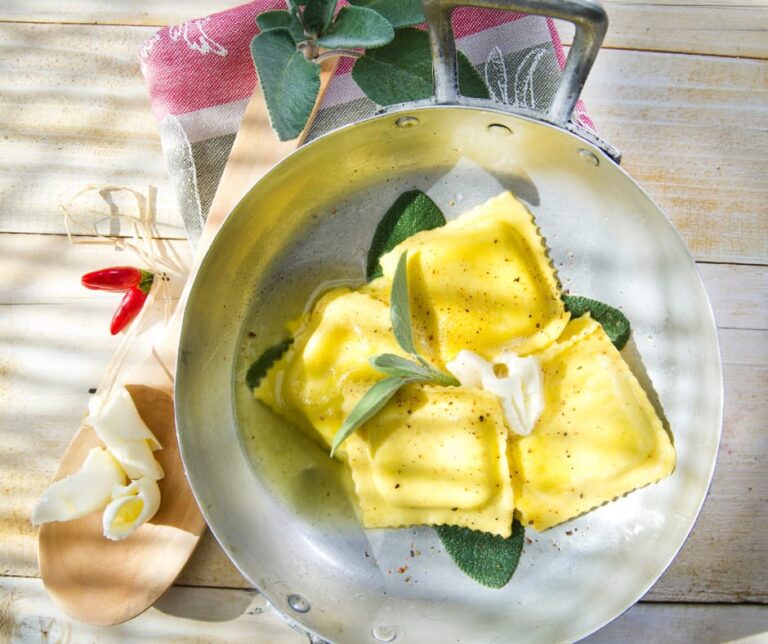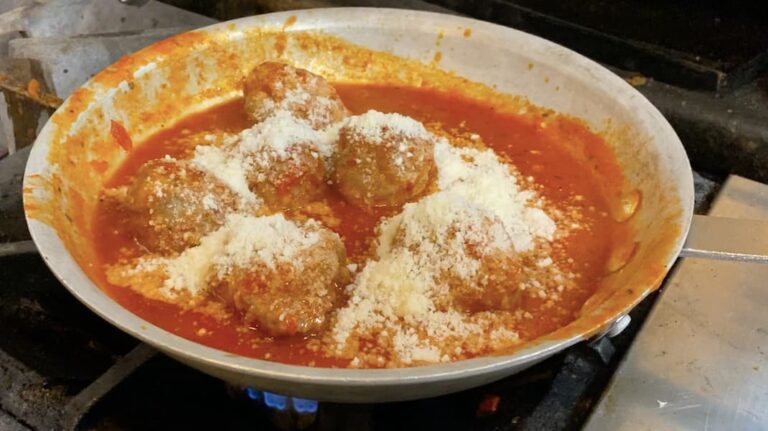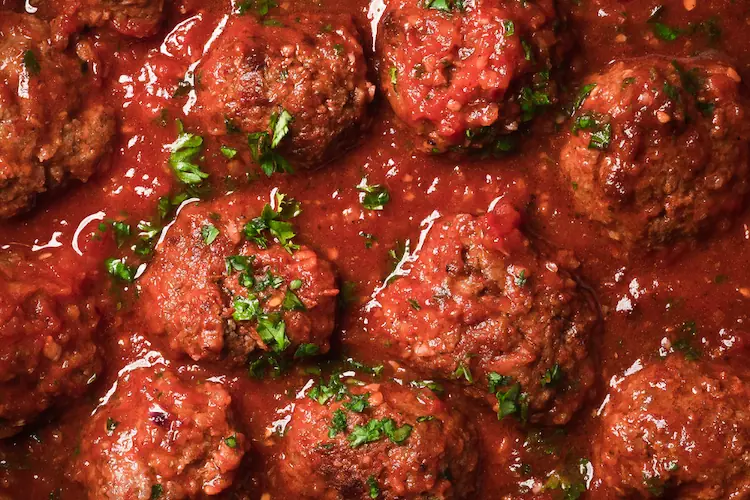The recipes I recently shared made me crave more stuffed pasta. So, I thought it would be fun to see how to make some fresh ravioli from scratch.
Making homemade ravioli can be a little time-consuming, but it is a lot of fun and can easily turn into a nice activity for the whole family. Your kids will love helping you to knead the pasta dough.
Since this is one of my favorite types of pasta, I thought I’d take things to the next level and write a complete guide with everything I know: what tools are needed, how long to boil fresh ravioli, how to dress them, what to serve them with, and some fun facts.
And I will do that with one of the simplest and most beloved ravioli recipes.
Table of Contents
Ravioli Burro & Salvia
The recipe we’re going to see today is called “ravioli burro e salvia“.
It’s the most traditional ravioli recipe that comes to mind, and I think it’s the best way to learn how to make them from scratch. It’s name translates to “butter & sage ravioli“. You can easily guess which ingredients will be used for the dressing.
In the next paragraphs, I’ll show you how to make this recipe step by step, and we’ll also see other possible dressings, so that you can find the one that suits you best.
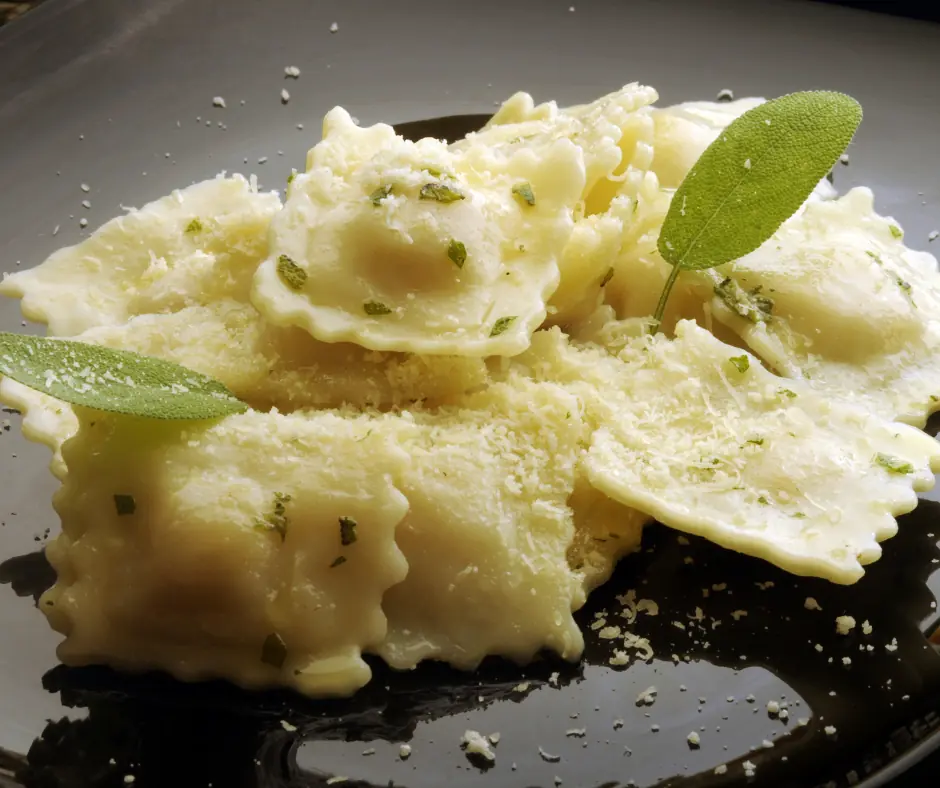
What you need
Ingredients
Making homemade ravioli from scratch requires the following ingredients:
- All purpose flour;
- eggs;
- water;
- ricotta;
- spinach;
- extra virgin olive oil;
- parmesan cheese;
- nutmeg;
- ground black pepper;
- coarse or Kosher salt.
You can find the precise amounts in the recipe card at the bottom of this post. You’re are also going to need some butter e sage leaves and coarse or Kosher salt for the dressing.
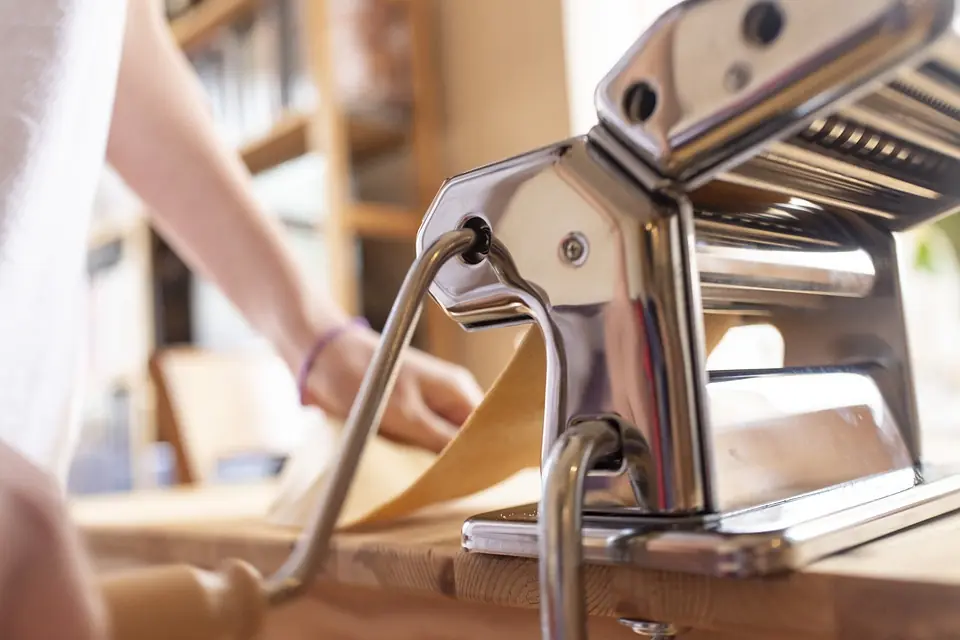
Tools
Since you’ll be making the pasta dough from scratch, you’re gonna need the following tools:
- a clean, flat, large work surface;
- a pasta machine;
- a pasta rolling cutter with toothed blades or a ravioli stamp, according to your preference.
I think the pasta cutter is more practical, as you can use it to make more than one type of pasta. However, anything that’ll do the trick will be good.
Some pasta machines already have enough accessories to make ravioli by themselves, so you might not need a cutter at all.
You will also need an immersion blender for the ravioli filling, along with a slotted spoon and a large strainer for when you’ll strain the ravioli.
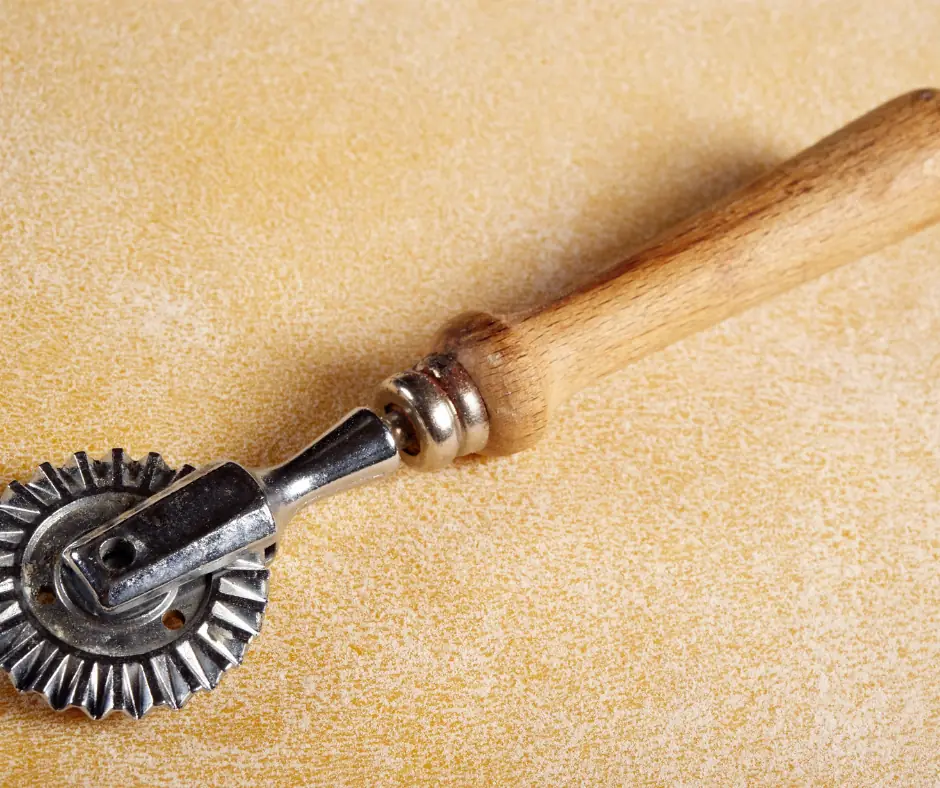
Method
There are 4 major phases for this recipe:
- making egg pasta sheets;
- making the filling;
- assembling the ravioli;
- cooking and dressing.
Now we’re going to cover all of them in detail. If you’re using store-bought or frozen ravioli, feel free to skip the first three parts.
Making the pasta sheets
Let’s start by making the egg pasta that we’ll use for assembling the ravioli. It’s a very basic pasta dough.
Take 4/5 of the flour, sift it, and pour it into the bottom of a large bowl, creating a sort of “crater” in the middle. Add the eggs to the center, mix them a little with a fork, and after a while start kneading with your hands until a smooth dough is created. If it is too tough, add a couple tbsp of warm water. On the other hand, if it is too sticky, add some of the flour you have kept aside.

Use the dough to create a ball, then wrap it in plastic wrap and set it aside for at least 30 minutes away from light. If you’re going to use it immediately, you can keep it at room temperature, otherwise it’s best to store it in the refrigerator for up to 2 days.
Now, let’s move on to the filling.
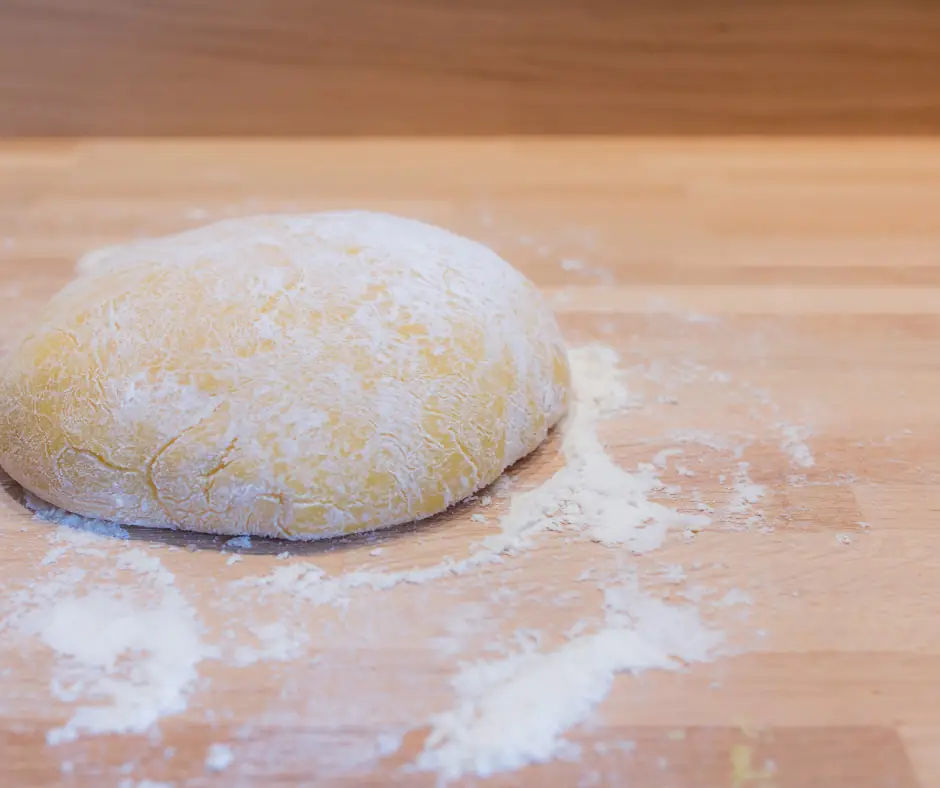
The easiest ravioli filling recipe
There are many ravioli fillings around. You can make them with meat, fish, cheese, or vegetables. My favorite one is the ricotta and spinach filling that I shared here a while ago.
You just have to heat the spinach with a couple of garlic cloves and a little olive oil, then blend it all together and combine it with a mix of ricotta cheese, parmesan cheese, nutmeg and black pepper powder
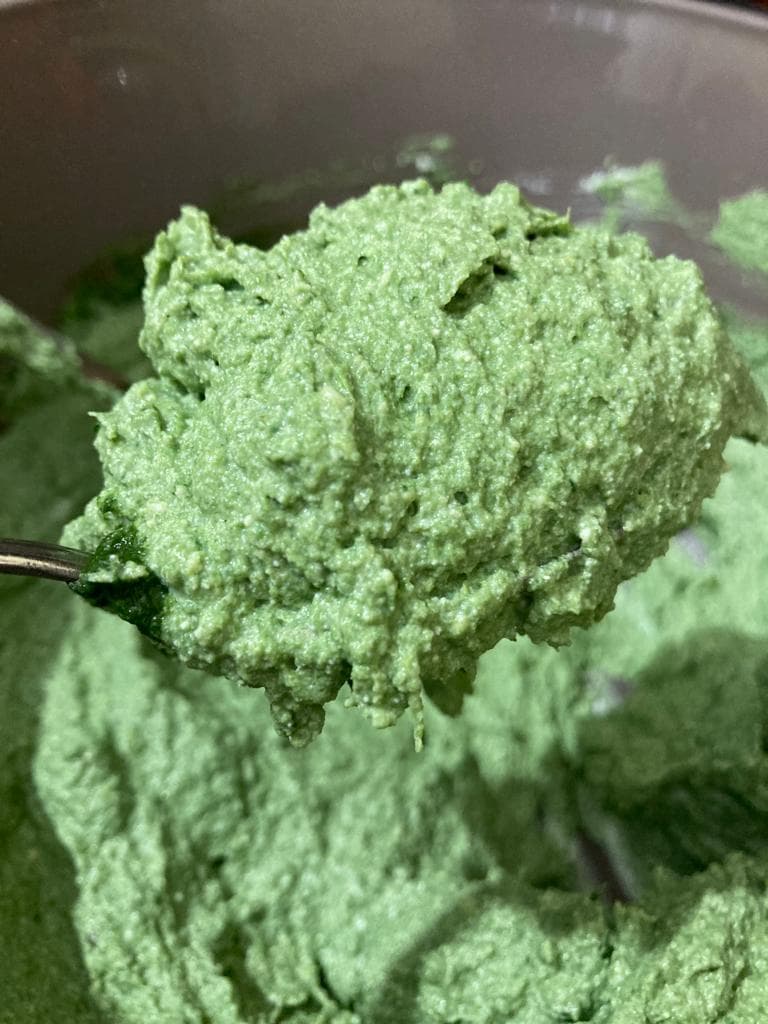
Making ravioli
Unwrap your homemade pasta dough, and divide it into two loaves. Lay one on a work surface, and wrap the other one again so it doesn’t dry out.
Flour the first one, and pass it through the pasta machine repeatedly until you get a long rectangular sheet about 1 mm (1/25 inch) thick.
Transfer the dough sheet to a floured work surface, then repeat the process with the dough loaf you had set aside.
Now, transfer the ravioli filling to a piping bag, and use it to create small filling balls on the first dough sheet. Arrange them in two rows, 1 inch away from each other.
After that, press the spaces around the filling balls with your fingers and use a kitchen brush or spoon to wet the edges of the sheet.
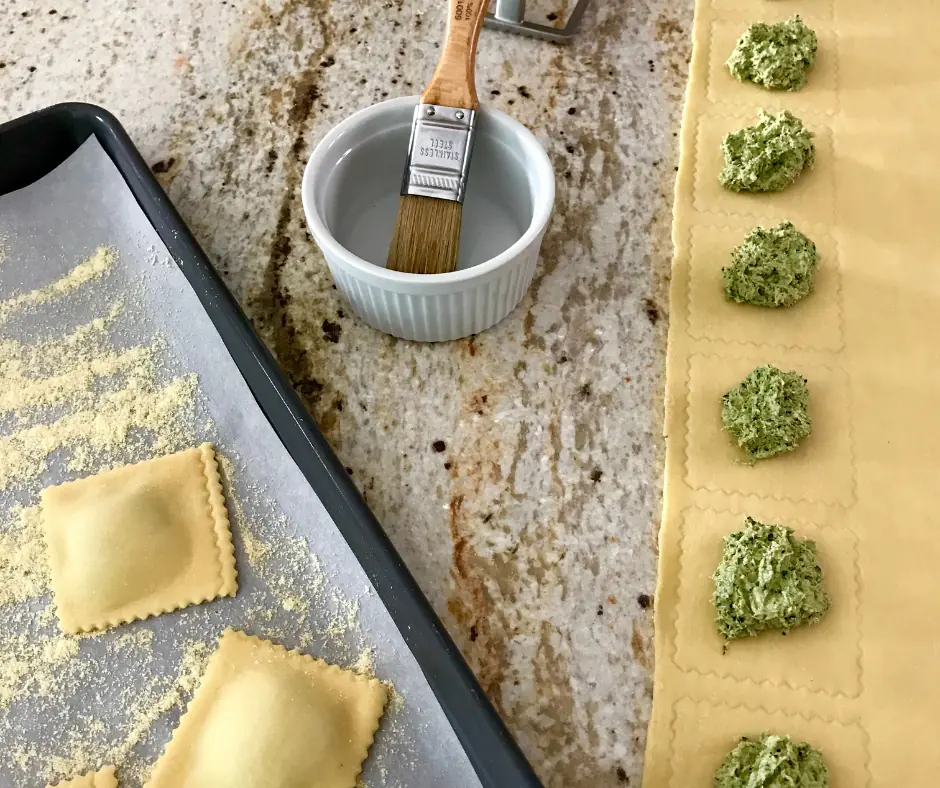
Lay the second pasta sheet on top of the first one, matching the edges. Press again with your fingers around the filling and the borders, and sprinkle a little extra flour all over them. After that, use the pasta cutter to cut out your ravioli and keep them aside on a floured tray or baking dish.
Now, take a large pot of water and bring it to a rolling boil. Use about 5 quarts of water for each pound of ravioli. When it boils, add a handful of coarse salt, wait one more minute, and toss in the ravioli.
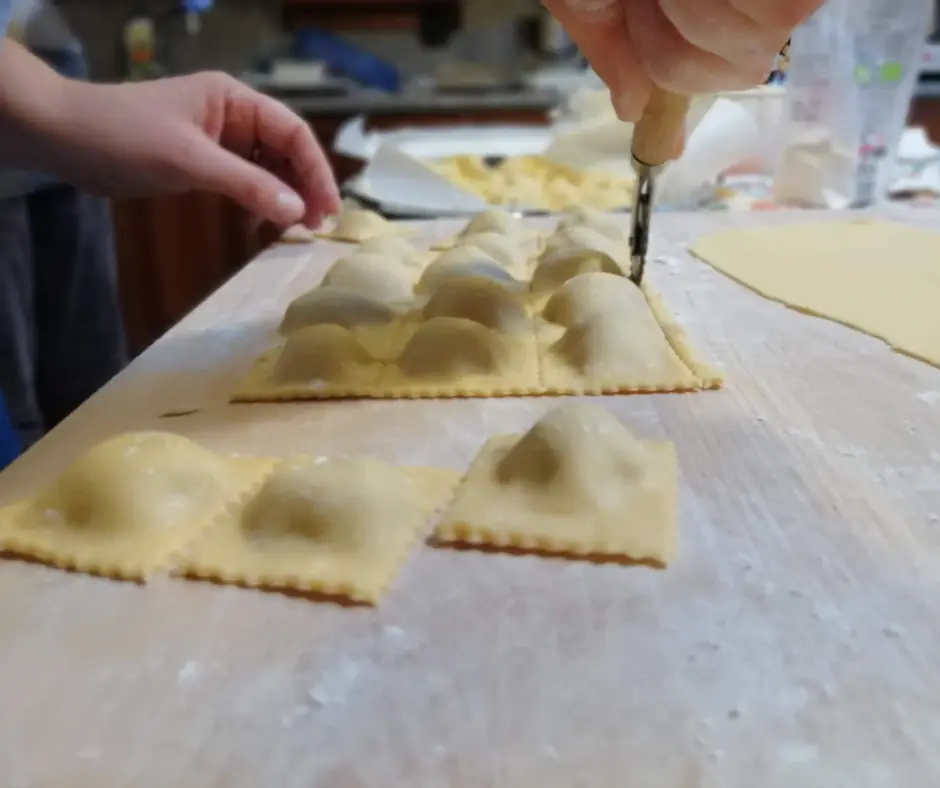
Cooking time: how long to boil fresh ravioli
Now, you may want to know how long to cook the ravioli you just made. After all, they have no boiling instructions written on their box. There’s no box to begin with.
The right amount of time depends on how fresh they are, and how well you stored them. Freshly made ravioli, for instance, take just 2 minutes to be ready – or maybe 3 minutes, if the pasta sheet you used is particularly thick.
Most of the time, you simply need to wait until they rise from the bottom of the pot to the surface of the boiling water. After that, taste one to check if they are ready, and leave them in the water for a few more seconds if they’re not.
On the other hand, if your uncooked ravioli are dry or have been stored for long, you might need to boil them for up to 8 or even 10 minutes.
Unlike other types of pasta, ravioli don’t have to be cooked al dente to be good. They give their best when they are soft, so don’t be afraid to let them float on top of the water for a little more if they still have too much of a bite.
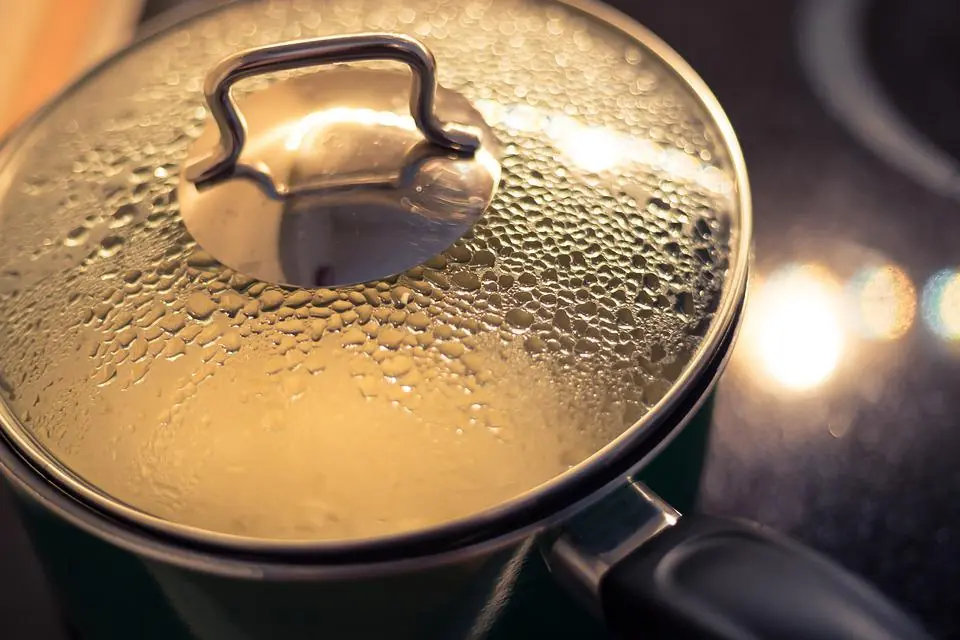
Dressing
As the fresh pasta cooks in the water, melt the butter in a little pot, then add the sage leaves and let them simmer over low heat for a few minutes, making sure you don’t burn them.
When the ravioli are ready, take them out with a slotted spoon and leave them in a large strainer. They’re too delicate to be strained directly, like you would do with spaghetti or other types of pasta. When the excess water is gone, put them in a bowl.
Remove the sage leaves from the butter, and add the latter to the ravioli, then add some extra parmesan cheese and ground black pepper, and mix everything. If you want, garnish with an extra couple of fresh sage leaves.
Your butter & sage ravioli are ready. You can serve them on a pasta dish. Enjoy them with a full-bodied red wine that balances with the fat components of butter and the flavors of the sage leaves – like a Barolo, a Monferrato Chiaretto, or a Chianti Classico.

Other easy ravioli recipes
If you’d like to try out other dressings aside from butter and sage, here are a few more options.
My favorite pasta sauce for ravioli is by far Bolognese sauce. Its meat and tomato parts complement the cheese and vegetables in the ravioli filling, creating the perfect flavor mix.
My 8-year-old nephew, on the other hand, likes them with just marinara sauce and parmesan cheese. It’s an easy dressing loved by many kids, and you can make it more flavorful by adding some fresh parsley or basil. If your not a big marinara fan, just switch it with your favorite tomato sauce.
The restaurant where my sister works serves ravioli with a dressing made of butter, crushed walnuts, shredded ciauscolo, and Varnelli liqueur. I haven’t tried to replicate it at home yet, but it’s definitely on my to-do list. It’s a great way to dress ravioli.
There are also other options depending on what filling you’re using. For instance, if you went for something that has mostly cheese, you can dress them with a walnut pesto. On the other hand, if you made a radish and speck filling (another common option), you can make a cacio & pepe dressing, or a quattro formaggi sauce with gorgonzola, mozzarella cheese, provolone and Emmental cheese.
Then there’s also shrimp sauce, bacon and peas, heavy cream, porcini mushrooms, even saffron… the choices are endless. I promise to write some more recipes soon and to add the links to this post. If you have a favorite sauce that you want me to cover, let me know in the comments.

Ravioli FAQs
What should you serve with ravioli?
If you type this question on platforms like Quora, you’ll find a bunch of angry Italians who will:
- argue that ravioli shouldn’t be served with anything else, or
- point out that you can’t have an answer because “it depends”.
In my opinion, both statements are not completely true.
Some people might consider ravioli a one-dish meal because of the various components of the filling and dressing. That’s legit, and if you’re heating frozen ravioli for your mid-week quick pasta dinner, you can just have them with a simple salad aside.
But at every family gathering, celebration or wedding that I ever attended, if ravioli were on the menu, they were always served as a main dish with appetizers, a second course, a side dish, and dessert. It might not be very diet-wise, but that’s what I’m used to.
You can easily make a good pairing by considering what’s in the filling.
For example, if it contains meat, try serving slices of veal topped with melted cheese and a piece of ham as a second course, and a chicken or feta salad as a side dish. I also like to serve ravioli with meat skewers.
If it contains fish instead, you could go with a salmon carpaccio and a tuna salad.
These are all very simple pairings, but you get the point. Choose something that goes well with the ravioli filling, and go with it.
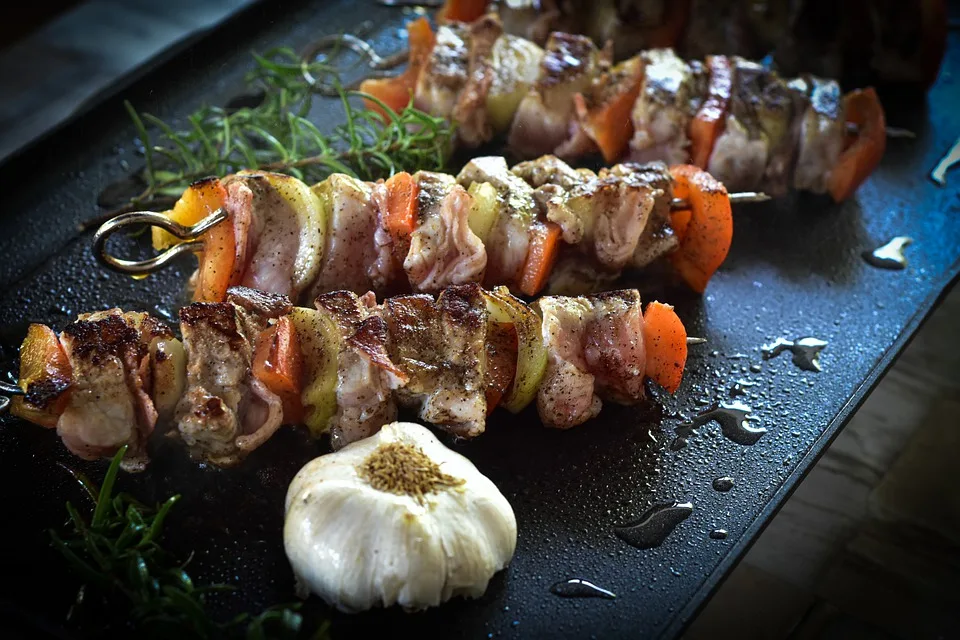
Is ravioli plural or singular?
In Italian, ravioli is a plural word, like spaghetti, tortellini or penne. Its singular form is raviolo.
However, you can use it as both a countable and an uncountable noun in English.
I still find it a little weird when I read things like “the ravioli cooks” or “as the ravioli floats“, though. It’s interesting how the same word can change from language to language.
How many ravioli should I make for 4 people?
Being stuffed pasta, a single raviolo weighs considerably more than a penna or spaghetto. Therefore, if you rely on the recommended quantities for other types of pasta, you will leave your guests hungry.
Many classy restaurants do it, but I hate that.
If you want to make your guests happy, you should use at least 200 grams of ravioli (about 10 pieces) for each of them. I often go up to 250 grams each, or even more. This means using at least 12 ravioli per person.
So, if you’re making ravioli for a group of 4 people, buy enough ingredients to make 1 kg of them. You’ll find the right amounts in the recipe card below.

What's the difference between agnolotti and ravioli?
To put it simply, we might say that agnolotti are the Piedmontese cousins of ravioli (although the two words are used synonymously in other regions).
You know that people in Italy like to argue about their regional foods a lot, so it’s not easy to tell the exact difference. They have similar shapes and typical dressings.
The only thing that separates agnolotti from ravioli is their filling. While ravioli can have many different fillings, many chefs and pasta makers agree that real Piedmontese agnolotti should be stuffed with meat only.
This, however, changes from region to region. And even in the parts of Piedmont that confine to Liguria, it is common to find agnolotti stuffed with meat and vegetables.
As for many similar debates, I like to think that the most important difference is the geographical one. Every local recipe has a different history and was made by different people. And in a place where you just need to take a 30-min car trip to find a different dialect and traditions, this matters a lot more than ingredients or shapes.
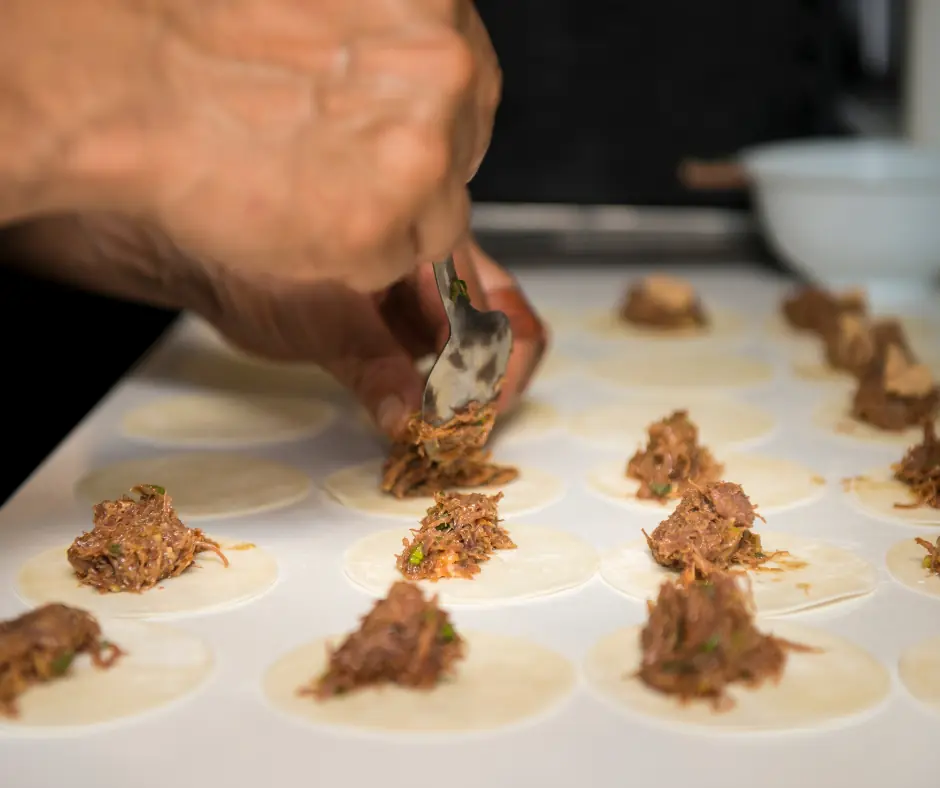
Recap & Recipe Card
Now you know everything you need to make perfect ravioli from scratch.
You’ve seen which tools to use, how much ravioli to make for each person, how long to boil them, what to serve with them, and all the different dressings you can use. And you’re (metaphorically) going home with a new traditional recipe!
Now, you just have to learn the right amount of each ingredient.
For that, I’ll leave you to the recipe card below. Adjust the settings according to your needs, use it from your smartphone as a shopping list (the ingredients can be toggled) or print it and keep it in your kitchen.
And most importantly, have fun doing these homemade ravioli burro e salvia! Buon appetito!

Butter & Sage Ravioli
5 Stars 4 Stars 3 Stars 2 Stars 1 Star
No reviews
- Author: Mortadella Head
- Total Time: 1 hour 35 minutes
- Yield: 24 pieces 1x
- Diet: Vegetarian
Ingredients
9 oz all-purpose flour
2 fresh eggs + 1 egg yolk
16 oz fresh whole milk ricotta
13 oz spinach
6 tbsp grated parmesan
1/3 stick of butter
5 fresh sage leaves
Coarse or Kosher salt to taste
Extra virgin olive oil to taste
Nutmeg powder
Ground black pepper
Instructions
For the ravioli pasta dough:
- Sift 4/5 of the flour and pour it into the bottom of a large bowl, or place it directly of a wooden work surface. Make it look like a volcano, with a crater in the middle.
- Add the eggs and egg yolk to the “crater”, mix them with a fork, then start kneading with your hands to create a smooth ball of dough.
- Wrap the ball in plastic film and set it aside for at least 30 minutes away from the light.
For the ravioli filling:
- Heat the spinach with a couple of garlic cloves and a little olive oil.
- Blend it.
- Combine in a large bowl with the ricotta, parmesan cheese, nutmeg and black pepper powder
Making ravioli:
- Unwrap the homemade pasta dough and divide it into two loaves. Lay one on a work surface, and wrap the other one again so it doesn’t dry out.
- Flour the first one, and pass it through the pasta machine repeatedly until you get a long rectangular sheet about 1 mm (1/25 inch) thick.
- Transfer the dough sheet to a floured work surface, then repeat the process with the dough loaf you had set aside.
- Now, transfer the ravioli filling to a piping bag, and use it to create small filling balls on the first dough sheet. Arrange them in two rows, 1 inch away from each other.
- After that, press the spaces around the filling balls with your fingers and use a kitchen brush or spoon to wet the edges of the sheet.
- Lay the second pasta sheet on top of the first one, matching the edges. Press again with your fingers around the filling and the borders, and sprinkle a little extra flour all over them.
- Use the pasta rolling cutter to cut out your ravioli and keep them aside on a floured tray or baking dish.
- Cook the ravioli in a large pot full with salted boiling water for 3 or 4 minutes. When they come up to the surface of the water, wait some more seconds and taste one of them. They should be ready.
For the dressing:
- While the ravioli are boiling, melt the butter in a small pot, add the sage leaves and let them simmer for a few minutes over low heat.
- Take the ravioli out of the water with a slotted spoon and leave them in a large strainer until they get rid of all excess water, then place them into a baking dish.
- Remove the sage leaves, and add the butter to the ravioli. If you wish, you can add some extra parmesan cheese and ground black pepper.
- Enjoy!
Notes
For this recipe, you’re going to need the following tools: a large working surface, a pasta machine, and a pasta rolling cutter with toothed blades (or, alternatively, a ravioli stamp).
I usually make 12 ravioli for each person, but if your guests are not big eaters you can go as low as 10 or even 8 ravioli per person.
- Prep Time: 90
- Cook Time: 5
- Category: Pasta
- Cuisine: Italian

